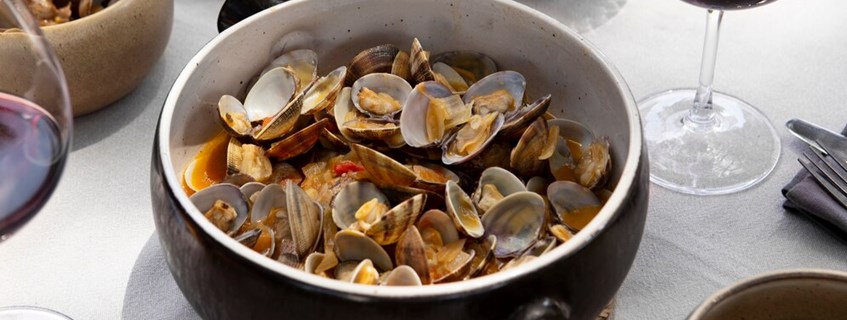
Traditional Spanish cuisine
Traditional Spanish cuisine is the result of centuries of development, in which influences from different cultures and regions are mixed. From Arabian influences to maritime tradition, every ingredient in the dish and every recipe has its own story. It's not just cooking; It is the preservation and transmission of cultural heritage through delicious tastes and aromas.
Cooking is central to the country's culture, becoming one of the key elements of its identity. Food in Spain is an integral part of the lifestyle, the basis of family traditions and an occasion for communication. Cooking and eating food in Spain is more than just a necessity; It is a ceremony in which all generations participate.
The traditional dishes of Spain are unique in their variety of regional characteristics. From the hot Andalusian plains to the verdant coasts of Galicia, each region contributes to the country's overall culinary heritage. Olive oil, garlic, pepper, seafood – these ingredients have become symbols of Spanish cooking. The richness of flavors and textures makes it one of the most recognizable and valuable cuisines in the world.

Popular Spanish dishes
- Paella – National Dish: Description, Ingredients, Preparation
Paella is an integral part of Spanish gastronomy. This dish, cooked in a special saucepan of the same name, combines aromatic rice, seafood, meat, olive oil and a variety of spices. In each region of Spain, paella can take on unique shades and variations, emphasizing local preferences. - Jamón is an important element of Spanish cooking: history and varieties
Jamón, or Spanish ham, is a cured and astringent pork leg. This exquisite meat undergoes a long process of drying and maturation. Depending on the region and the time of ripening, the ham can have different flavors – from sweet to rich and spicy. - Meat Dishes: Traditional Meats and Their Uses in Spanish Cuisine
Spaniards are masters of cooking meat, and this is reflected in their traditional dishes. Carnegie, chorizo, sobrasad – the variety of meat products is a key element of many dishes, giving them a special taste and character. - Olive Oil – An Integral Component of Hot Dishes: Its Role and Uses
Olive oil plays an important role in Spanish cooking, being an integral part of hot dishes. It is used for frying, dressing, and adding flavor. The high quality of Spanish olive oil gives dishes a unique taste and makes them healthier. - Pepper in Spanish Cooking: Variety and Uses
Pepper is one of the key elements of Spanish cuisine, giving dishes their characteristic taste and aroma. From sweet paprika to spicy chili, peppers are used in a variety of forms, highlighting the flavor of meat, fish, and vegetable dishes.
These dishes are an integral part of the Spanish cultural tradition, presenting a unique combination of flavors and aromas at each meal.
Snacks & Traditional Drinks
- Tapas – a Spanish appetizer: a variety of options and their combination
Tapas is a true art that allows you to experience a variety of flavors and textures. From tiny bruschettas and mini empanades to shrimp in garlic sauce and anchovy olives, tapas provide the opportunity to enjoy many variations in a single meal. It is important to note that traditionally, tapas are served in bars as a companion to drinks. - Eggs in Spanish Cuisine: Popular Egg-Based Dishes
Eggs are an essential ingredient in Spanish appetizers, providing endless opportunities for culinary creativity. Tortilla Española, or Spanish omelette, is one of the most popular dishes where eggs are combined with potatoes and various fillings. - Olive Oil in Appetizers: Uses and Traditions
Olive oil, in addition to its use in hot dishes, plays an important role in Spanish appetizers. Buttered toast, pickled vegetables and cheeses with olive oil become exquisite flavor compositions.
Spanish Drinks: Role in the Culinary Tradition and National Preferences
Drinks in Spain have a peculiar meaning in the culinary tradition. From the traditional sangria, made with red wine, fruit and soda, to the ancient sherry, the Spaniards know how to enjoy a variety of flavors. Traditional drinks such as tinto de verano and cava accompany moments of communication and reflect the preferences of each region.
These snacks and drinks provide the opportunity to enjoy the diversity of Spanish cuisine in the company of friends and family, highlighting the socio-cultural aspects of the meal.

Wrapping Up: Spanish Cuisine in a Global Context
Spanish restaurants are successfully winning the hearts of gourmets abroad. From small tapas bars to luxury restaurants offering outstanding cuisine, Spanish cuisine has become an integral part of the global culinary experience. These establishments provide the opportunity to enjoy the authentic flavors of Spain without leaving your city.
Traditional Spanish cuisine has become a symbol of Spain's national brand. Paella, tapas, jamón and other recognizable dishes are not only delicious but also part of the country's cultural heritage. They highlight the richness and diversity of Spanish culture, attracting the attention of a global audience.

